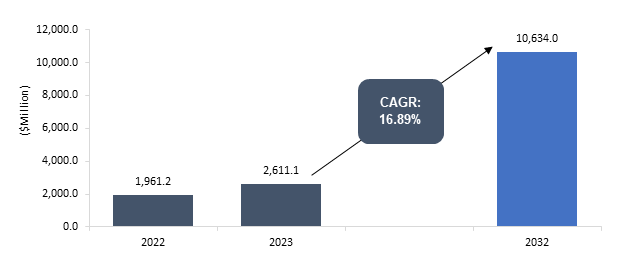Global Battery Manufacturing Scrap Recycling Market Overview
The global battery manufacturing scrap recycling market was valued at $1.96 billion in 2022, and it is expected to grow at a CAGR of 16.89% to reach $10.63 billion by 2032. The battery manufacturing scrap recycling is a fast-expanding industry that deals with the manufacturing of scrap materials generated during the manufacturing process of battery cells. The market for these batteries is anticipated to expand rapidly as electric vehicles gain popularity, which will also fuel the expansion of the battery manufacturing scrap recycling technologies. In addition, there are a few key players who dominate the battery manufacturing scrap recycling market, including Umicore, BASF SE, Tenova S.p.A., and many more. Nonetheless, a large number of new competitors are anticipated to enter the market in the upcoming years, increasing competition and spurring additional growth and innovation.
Market Lifecycle Stage
The global battery manufacturing scrap recycling market is in a growing phase. New trends, such as targets for ethical supply chain and decarbonization, increasing focus toward secondary battery materials, rising investments in recycling technologies, change in business models of companies due to climate action, increasing demand for lithium-ion batteries and raw materials across the value chain, and development of economic and environmental technologies, are further expected to provide opportunities for the market to grow in the coming years.

Industrial Impact
Battery manufacturing scrap recycling market has a large industry influence since it provides numerous environmental and economic benefits. Furthermore, it has a significant effect on end-use sectors since it provides a plethora of benefits that can increase their efficiency, lower their costs, and give them a consistent source of important metals.
With an increased worldwide focus on circular economic principles and the advancements in recycling technologies for the recovery of high-performance metals from manufacturing scrap, there is an increasing shift toward the demand and consumption of batteries such as lithium-ion in the end-use industries. Thereby creating demand for the recycling of battery manufacturing scrap. Additionally, the shift is more prominent in the automotive and energy sectors in regions such as China, Asia-Pacific and Japan, North America, and Europe.
Market Segmentation:
Segmentation 1: by Scrap Source
• Automotive Batteries
• Industrial Batteries
• Consumer Electronics Batteries
• Others
Based on the scrap source, the automotive batteries segment dominated the global battery manufacturing scrap recycling market in 2022.
Segmentation 2: by Recycling Technology
• Hydrometallurgy
• Pyrometallurgy
• Others
Based on the recycling technology, the hydrometallurgy segment dominated the global battery manufacturing scrap recycling market in 2022. It is one of the most significant recycling technologies, which meets the requirements of major industrial application areas.
Segmentation 3: by Application
• Automotive
• Electronics
• Energy and Power
• Aerospace and Defense
• Construction
• Others
Based on the application, the automotive segment dominated the global battery manufacturing scrap recycling market in 2022.
Segmentation 4: by Region
• North America - U.S., Canada, Mexico
• Europe - Germany, France, Italy, Poland, and Rest-of-Europe
• U.K.
• Asia-Pacific and Japan - Japan, India, South Korea, Australia, and Rest-of-Asia-Pacific and Japan
• China
• Rest-of-the-World - Middle East and Africa and South America
Based on region, in 2022, China was the dominant region, accounting for a share around 24.8% of the global battery manufacturing scrap recycling market.
Recent Developments in the Battery Manufacturing Scrap Recycling Market
• In February 2023, manganese-rich battery material technology for electric vehicles is being industrialized by Umicore. This significant achievement expands Umicore's wide spectrum of nickel, manganese, and cobalt (NMC) battery materials for exceptional productivity and long-range EVs. It also introduces a distinctly competitive technology to existing design-to-cost battery technologies for EVs.
• In September 2022, General Motors Co. and Lithion Recycling invested strategically in Lithion Recycling’s Series A fundraising round in support of a new strategic collaboration agreement between the two companies. This investment aims to create a circular battery ecosystem employing Lithion Recycling’s cutting-edge battery recycling technology.
Demand – Drivers and Limitations
Following are the drivers for the global battery manufacturing scrap recycling market:
• Increasing Government Regulations toward Battery Waste Management
• Growing Investment in Scrap Recycling from Battery Manufacturers
Following are the challenges for the global battery manufacturing scrap recycling market:
• Complexities Associated with Different Battery Chemistries
Analyst Thoughts
According to Dhrubajyoti Narayan, Principal Analyst at BIS Research, “Battery manufacturing scrap recycling is the technique of recovering priceless metals and other materials from manufacturing scrap generated during the production process of battery cells. This battery manufacturing scrap is mainly from cell manufacturers for automotive, consumer electronics, and industrial applications. The rising sustainable initiatives, increasing government funding, and focus on closing the loop for batteries are leading to the rise in recycling initiatives. Moreover, battery manufacturing scrap is the source for extracting metals with high purity and is also economical. Furthermore, the presence of a large number of battery chemistries needs focused technologies for recycling metals from battery manufacturing scrap.”

